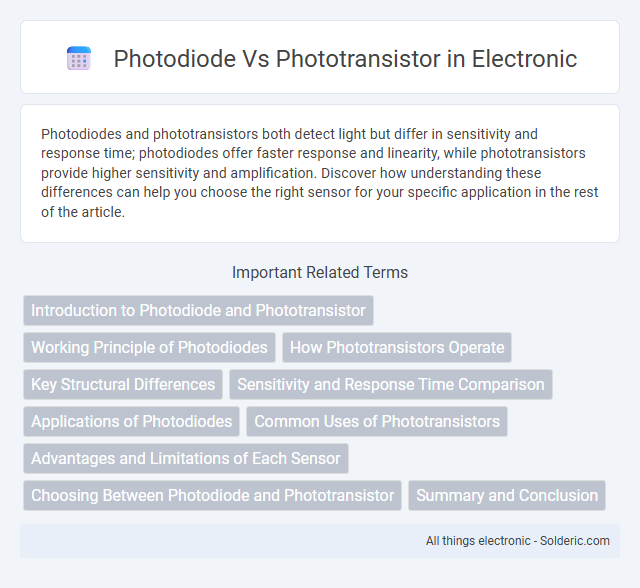Photodiodes and phototransistors both detect light but differ in sensitivity and response time; photodiodes offer faster response and linearity, while phototransistors provide higher sensitivity and amplification. Discover how understanding these differences can help you choose the right sensor for your specific application in the rest of the article.
Comparison Table
| Feature | Photodiode | Phototransistor |
|---|---|---|
| Working Principle | Converts light into current using a semiconductor junction | Amplifies photocurrent using transistor action |
| Response Speed | Fast (nanoseconds to microseconds) | Slower (microseconds to milliseconds) |
| Sensitivity | Lower sensitivity | Higher sensitivity due to internal gain |
| Output | Current proportional to light intensity | Amplified current output |
| Application | High-speed optical communication, light measurement | Remote controls, light sensing with amplification |
| Noise | Lower noise | Higher noise due to gain |
| Biasing | Reverse biased | Forward biased (base-emitter junction) |
| Cost | Generally lower cost | Generally higher cost |
Introduction to Photodiode and Phototransistor
Photodiodes are semiconductor devices that convert light into electrical current, offering fast response times and high accuracy in light detection. Phototransistors function as light-sensitive transistors, amplifying the electrical signal generated by incident light, which results in higher sensitivity compared to photodiodes. Both components are essential in optical sensing applications, with photodiodes preferred for precision measurements and phototransistors favored for signal amplification.
Working Principle of Photodiodes
Photodiodes operate by converting light into an electrical current through the photovoltaic effect, where photons hitting the semiconductor material generate electron-hole pairs. They are designed with a p-n junction that produces current proportional to the intensity of incident light, enabling fast response times and high sensitivity. Compared to phototransistors, photodiodes provide more linear output and are preferred in applications requiring precise light measurement and high-speed detection.
How Phototransistors Operate
Phototransistors operate by converting light into electrical current, amplifying this current through a transistor effect, unlike photodiodes that only generate current directly from light exposure. When photons hit the phototransistor's base region, they create electron-hole pairs that enhance the flow of current from collector to emitter, resulting in higher sensitivity and gain. Your choice between a photodiode and a phototransistor depends on the required signal amplification and response speed in your application.
Key Structural Differences
Photodiodes consist of a simple p-n junction that converts light into electrical current with fast response times, while phototransistors incorporate a transistor structure with a base region that amplifies the photocurrent for higher sensitivity. The phototransistor's additional transistor layers enable greater current gain, whereas the photodiode's streamlined design allows for lower noise and quicker operation. Your choice depends on whether you prioritize speed and linearity (photodiode) or enhanced signal amplification (phototransistor).
Sensitivity and Response Time Comparison
Phototransistors exhibit higher sensitivity than photodiodes due to their internal gain mechanism, making them ideal for detecting low light levels. Photodiodes, however, offer faster response times because of their simpler structure and lower junction capacitance, crucial for high-speed applications. Choosing between the two depends on whether Your priority is sensitivity or rapid response in light detection.
Applications of Photodiodes
Photodiodes are widely utilized in solar energy harvesting, optical communication systems, and medical devices due to their fast response time and high sensitivity to light intensity. They excel in applications such as barcode scanners, light meters, and smoke detectors where precise light measurement is essential. Unlike phototransistors, photodiodes offer linearity and stability, making them ideal for high-speed and accurate optical sensing applications.
Common Uses of Phototransistors
Phototransistors are widely used in applications requiring high sensitivity and fast switching, such as in optical sensors, smoke detectors, and remote control receivers. Their ability to amplify light signals makes them ideal for precision light measurement and automation systems in industrial environments. Your choice of phototransistor can enhance performance in devices needing reliable light detection and signal processing.
Advantages and Limitations of Each Sensor
Photodiodes offer faster response times and higher linearity, making them ideal for high-speed and precise light detection applications, but they produce weaker signals requiring amplification. Phototransistors provide built-in signal amplification, resulting in higher sensitivity and stronger output without additional circuitry, yet they have slower response speeds and less linearity compared to photodiodes. Understanding these advantages and limitations helps you choose the right sensor for your specific light sensing needs.
Choosing Between Photodiode and Phototransistor
Choosing between a photodiode and a phototransistor depends on the specific application requirements such as speed, sensitivity, and output signal strength. Photodiodes offer faster response times and high linearity, making them ideal for high-speed optical communication and precision sensing. Phototransistors provide higher sensitivity and amplified output, which is beneficial in low-light conditions or when simplicity and cost-effectiveness are priorities.
Summary and Conclusion
Photodiodes offer faster response times and higher linearity, making them ideal for high-speed and precise light detection applications. Phototransistors provide greater sensitivity and current amplification, suitable for low-light conditions but with slower response and more noise. Choosing between them depends on the specific requirements for speed, sensitivity, and signal strength in optical sensing tasks.
photodiode vs phototransistor Infographic

 solderic.com
solderic.com